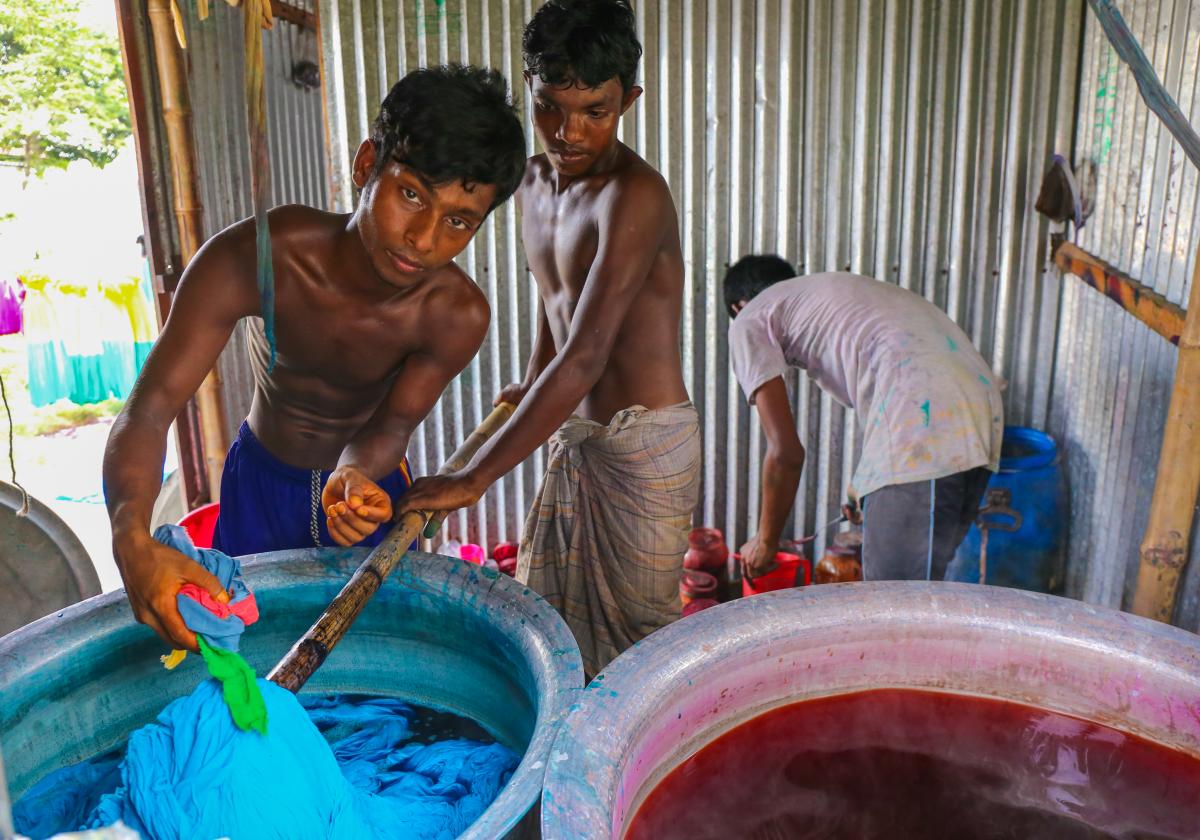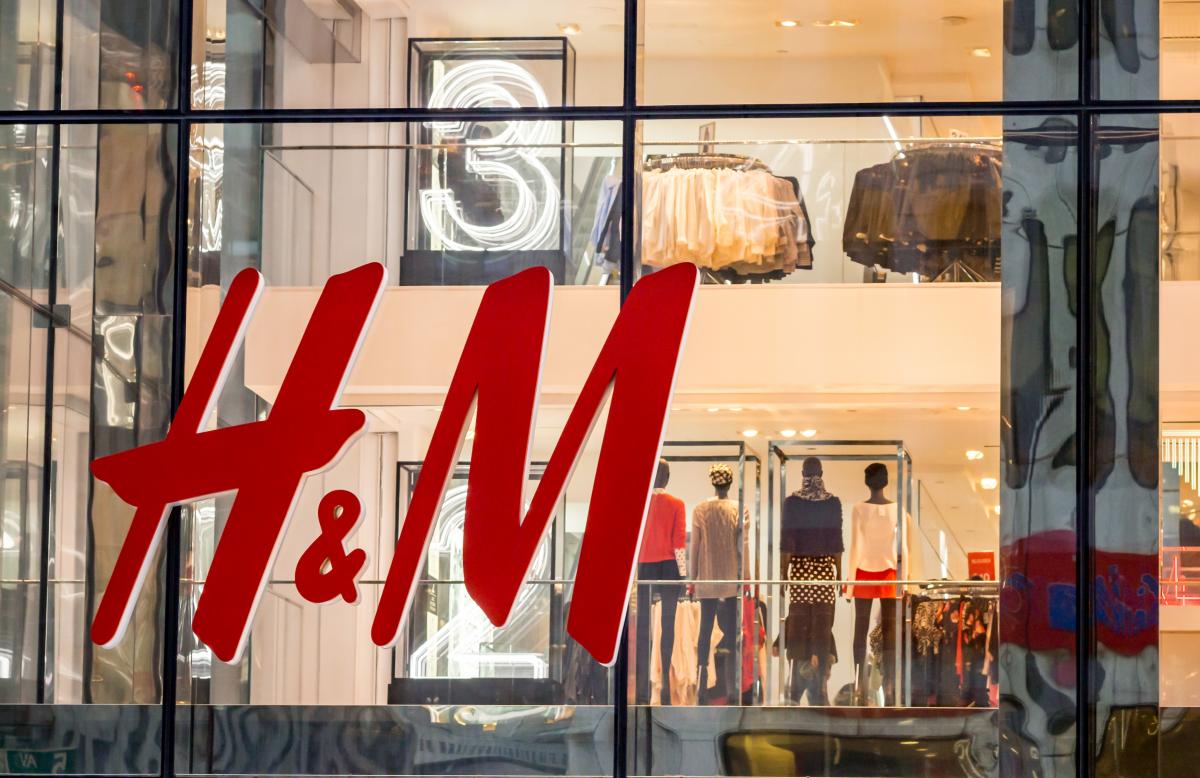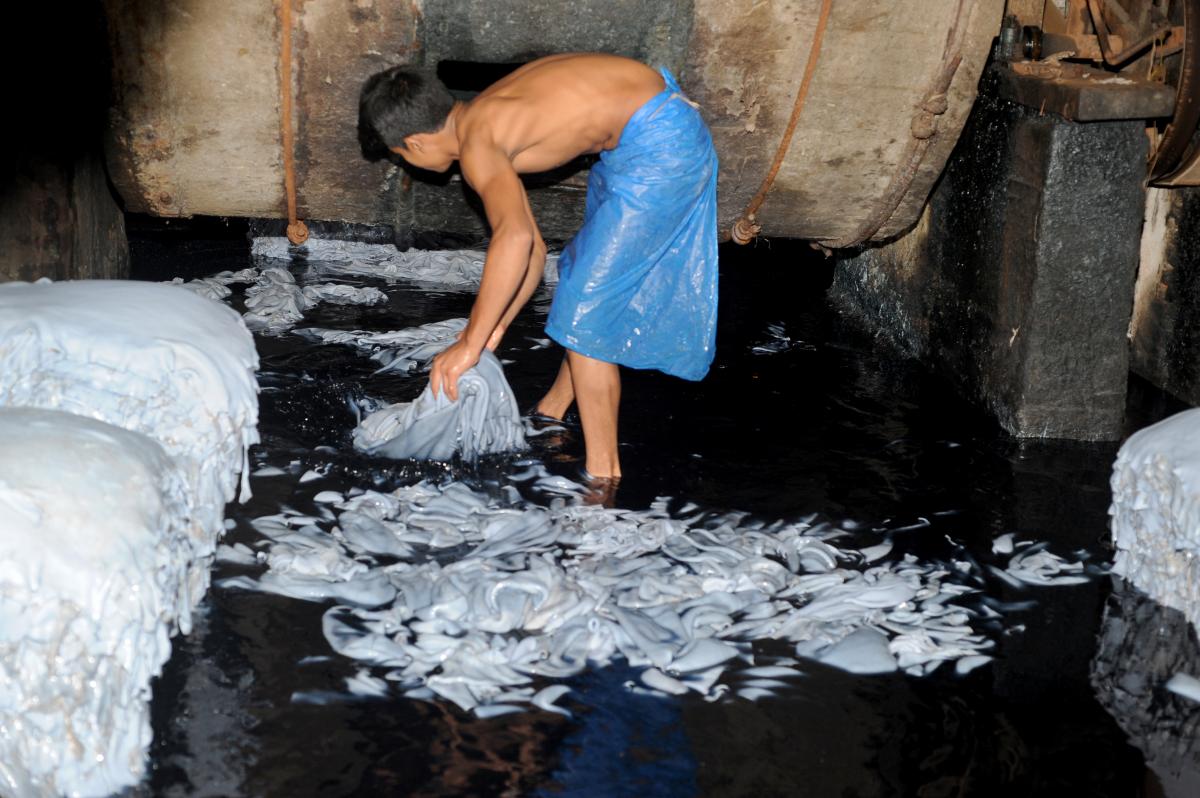Angeli Mehta reports on how collaborative platforms such as the Partnership for Cleaner Textile are pushing for improvements in one of the world’s most polluting industries
The textile industry is one of the world’s biggest consumers of water, with the washing, dyeing and finishing processes all using copious amounts – not to mention the high water requirements of cotton, a crop that is twice as thirsty as major food crops such as rice, according to PwC.
The industry is also a huge polluter, with textile treatments and dyeing responsible for 20% of all freshwater pollution globally. In the watershed area of Dhaka in Bangladesh, for example, industrial pollution accounts for 60% of water pollution – with textiles the second largest contributor after tanneries. The International Finance Corporation (IFC) estimates that in 2017 more than 700 washing, finishing and dyeing factories were discharging 200,000 litres of wastewater per tonne of fabric.
Western fashion brands are beginning to see how they can have an impact on water use and pollution. Collaborative approaches are being developed with the likes of WWF in China and Turkey, and the International Finance Corporation and NGO Solidaridad in Bangladesh, bringing together brands, factories and finance to kickstart cleaner production.
75% of consumers questioned says brands should be required by law to protect the environment at every stage
Indeed European research suggests that this is exactly the type of action that consumers want to see. A survey for Fashion Revolution found that 75% of those questioned say brands should be required by law to protect the environment at every stage of making their products. Almost 90% said it was important that brands tackle climate change and environmental protection. While those figures don’t entirely appear to translate into consumer action, 37% said it was important that the clothing they buy is produced in a way that is not harmful to the environment.
In Bangladesh, H&M, Inditex, and C&A are sponsoring the Partnership for Cleaner Textile (PaCT), whose aim is to tackle water, energy and chemicals use in the entire textile industry.
Programme manager Nishat Shahid Chowdhury is leading the factory outreach effort, and advising on best practice. “Thirteen international brands all joined hands to push a common sustainability agenda,” she explains.

The first phase of the programme concentrated on cleaner production, and has involved 250 factories. Brands subsidised initial audits of their nominated supplier factories to get the programme going, and in the five years since they’ve implemented various methods of best practice. Factories are seeing returns on their investments. In one trouser-making facility, replacing steam dryers with thermal oil heaters cut water consumption by over 70%, as well as saving energy.
A few months after PaCT was set up in 2013 came the Rana Plaza disaster, in which more than 1,100 textile workers were killed. “When Rana Plaza happened, everything shifted,” says Chowdhury. Brands saw results from implementing fire and safety recommendations and at the same time factories joining the PaCT programme were seeing that they could save money by implementing best practice for energy and water, which in turn they could invest in improving safety measures.
Brands also have a lot to learn. PaCT has been educating designers on the impact of their decision making – for example, which dyestuffs cause the most pollution – in an effort to encourage them to consider sustainability at the design and sourcing stage. “The next logical step,” says Sebastian Taylor of Solidaridad, which worked on developing a decision support tool, “is for them to realise the impact of their specifications”. For example, stipulating a particular colour of fabric and then asking for a lighter shade requires fading, and that demands chemicals, energy and water.
It’s only been possible because all 13 brands, and Bangladesh’s textiles association, pushed for change
Adopting cleaner production methods requires an enabling environment, meaning regulation and access to finance. PaCT advocated to get taxes cut on expensive equipment such as energy-saving LED lighting. And tax and VAT have been increased from 5% to 25% on three toxic chemicals that the programme for Zero Discharge of Hazardous Chemicals (ZDHC) says should be banned.
When PaCT was set up, no bank was providing finance for resource-efficient technology. “It was a case of educating the banks,” says Chowdhury. This meant “providing benchmarking tools, and a resource efficiency calculator, so that the bank can see whether it makes sense to offer loans to a factory”.
She adds: “It’s only been possible because all 13 brands, and Bangladesh’s textiles association, pushed for change.”

PaCT has been able to mobilise $975,000 from its financial partners to support investment in technology upgrades. Factories also have access to a $200m export development fund, and a one-stop shop for advice on new technologies.
But factories don’t work in isolation. A water footprint assessment of the textiles cluster in one part of Dhaka revealed that it was consuming the bulk of the area’s available freshwater – some 13 billion litres a year.
Now PaCT is working on developing centralised solutions to wastewater and sludge management and encouraging factories to implement sustainable practices. PaCT also has to grapple with failures of regulation: “You can make a business case for technology to reduce effluent costs, but it’s completely negated by low penalties for regulatory failure. And in Bangladesh, factories do directly discharge effluent,” says Taylor.
WWF wants the brands it works with to 'step up to become water stewards'
H&M was one of the first companies to use the Water Risk Filter tool, launched six years ago by WWF and German development finance institution KFW DEG to help companies tackle water risk both in their own operations and collectively at a basin level.
“It was only a database at the start,” explains Charlotta Järnmark, programme manager for water stewardship at WWF. “The idea was that investors would be able to test whether companies were aware of the material risks in the areas they were operating. Now it’s a mitigation toolbox.”
Companies get detailed advice based on 130 indicators, from which they should be able to set targets and build a comprehensive action plan to address water risk, says Järnmark. This can take up to three years, and involves mapping the supply chain. A new section will shortly be added, enabling companies to “begin to calculate value potentially affected by water risk”.

WWF wants the brands it works with to “step up to become water stewards, to encourage others in better management of water, and engage local and national decision makers,” says Järnmark. If engagement is working, the baselines of river basin health should improve.
Most recently, H&M has been working with WWF on projects in China. A third of its suppliers there and in Bangladesh and India, which are involved in wet processing, are operating in areas that are, or will soon be, water-scarce.
In China, Järnmark points out, H&M has a lot of suppliers, so a lot of influence. WWF and H&M have pulled in Tommy Hilfiger and US home textiles group Target. They are pushing the China National Textile and Apparel Council (CNTAC), to promote better policies, and engaging national and local government on governance.
It’s not about cleaning one single brand´s supply chain but securing long term sustainability for the business
H&M has fewer suppliers in Turkey, where a new project aims to cut pollution in one of the country’s most important river basins, the Büyük Menderes. Having an impact there will depend on getting more brands to join. Inditex, another of PaCT’s backers, has confirmed that it, too, will work with WWF on the programme.
Kim Hellström, strategy lead for climate and water at H&M Group told Ethical Corporation: “We recognise such collaboration is required not only within [the] textile industry but also beyond, for other basin users. It’s not about cleaning one single brand´s supply chain but securing long term sustainability for the business.”
H&M’s ambition is to expand cleaner production beyond the Büyük Menderes region. Helpfully, one of Turkey’s private banks, Garanti Bank, sees clean production technology as “bankable” and is, according to WWF, ready to provide favourable loans to manufacturers who want to revamp their production processes.

Another WWF project is aiming to clean up the water that Kanpur’s tanneries flush into the highly polluted river Ganges in India. Funded by HSBC, 10 companies, including John Lewis, Arcadia, Tesco and New Look, have joined the Ganges Leather Buyers Platform.
Again, the strategy is benchmarking, and demonstrating financial, environmental and social benefits of implementing clean technologies, says Lucy Lee of the WWF water stewardship team in the UK.
Examples include recovery and reuse of chromium (a toxic chemical used to tan leather); preventing animal flesh being dumped in the river; and developing effluent plants at the tannery level, while making efforts to improve a city-wide effluent processing system that currently doesn’t work well. Progress is sufficiently encouraging for the platform group to plan to scale up to other leather clusters in India.
Working with brands gives you leverage, but it’s inherently limited
H&M and WWF have called for a global platform to increase collaboration on water stewardship. It’s clear that efforts have to move beyond the same European and North American brands who partner WWF and others, and start to tackle the big volume producers.
The question is how? Last year, a highly critical report from NGO Changing Markets Foundation on dirty practices in the viscose industry did have an impact amongst some brands and encouraged ZDHC to look beyond chemicals used in dyeing and finishing to raw materials production.
A joint working group has been set up to develop the criteria. China’s top producers developed a roadmap to meet international standards on both wastewater and sustainable sourcing of wood pulp, which is used in the manufacture of viscose.
However, when Changing Markets followed up on actions taken by both brands and viscose fibre producers, it found that the world’s biggest, India-based Aditya Birla Group, had not acted to stop discharge of untreated waste water at two of its major plants. (See, Fashion brands ‘failing to heed warnings on viscose production’)

Ways also have to be found to pull in the small factories, which aren’t the strategic suppliers brands usually support.
“Working with brands gives you leverage,” says Solidaridad’s Taylor, “but it’s inherently limited … opening up a greater gap between the top layer of best-performing factories and those where there is no help.”
Solidaridad is working on self-assessment tools that could be offered by local textile associations to offer at least some support, he suggests.
In Bangladesh, PaCT is now in phase two, expanding to cover renewable energy, chemical management, and energy efficiency. Chowdhury wants factories to nominate themselves, rather than being chosen by brands. So far 49 have signed up, although there may be as many as 3,500 to reach across the whole country.
Angeli Mehta is a former BBC current affairs producer, with a research PhD. She now writes about science, and has a particular interest in the environment and sustainability. @AngeliMehta
Sustainable fashion textiles pollution PaCT H&M sustainable leather

